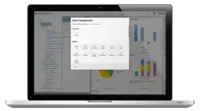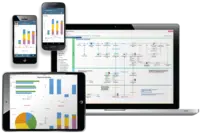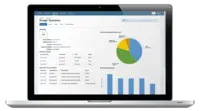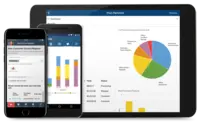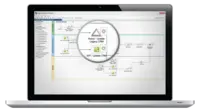Overview
What is Appian?
Appian is a low-code development and business process management platform. It features drag-and-drop design for app building, automated work processes, unified data management, and cloud-based deployment.
Great Low code - no code Workflow tool in the market!!
TrustRadius Insights
Appian Is The Best Low ode Plateform
Low-code Prog: The Best Way To Digitalize Your Life
Best in class BPM tool
Appian is one of the best Low Code platform
BEST BPM TOOL - APPIAN
Quickly deliver upon your ROI goals
Leading us into the future
Appian--reduce time and effort for employees
remote user
A+ for Appian
its helpful
very good workflow software
Awards
Products that are considered exceptional by their customers based on a variety of criteria win TrustRadius awards. Learn more about the types of TrustRadius awards to make the best purchase decision. More about TrustRadius Awards
Popular Features
- Platform Scalability (73)9.494%
- Reusability (75)9.494%
- Drag-and-drop Interfaces (72)8.989%
- Visual Modeling (73)8.888%
Reviewer Pros & Cons
Pricing
Appian Community Edition
$0
Application - Input-Only
$2
Application - Infrequent
$9
Entry-level set up fee?
- No setup fee
Offerings
- Free Trial
- Free/Freemium Version
- Premium Consulting/Integration Services
Product Demos
APPIAN DEMO RECORDING SESSION # 91-9866955524
Appian Developer Tutorial for Beginners | Appian Training
APPIAN DEMO
APPIAN DEMO | Harsha Trainings |
Features
Low-Code Development
Low-code development tools allow non developers to build simple process applications with little oversight. These tools simplify the application building process, and are frequently used for simple process applications.
- 8.8Visual Modeling(73) Ratings
Visual modeling tooling allows business users to design processes visually.
- 8.9Drag-and-drop Interfaces(72) Ratings
Drag-and-drop interface for building applications
- 9.1Platform Security(71) Ratings
Security guardrails in place to help prevent malware, data breaches etc.
- 8.8Platform User Management(72) Ratings
Tools enabling admins to control user access and on-board and off-board users
- 9.4Reusability(75) Ratings
An internal repository where assets, modules, and even entire applications can be reused
- 9.4Platform Scalability(73) Ratings
Apps developed by low-code platform must be scalable and capable of supporting large numbers of users
Product Details
- About
- Competitors
- Tech Details
- Downloadables
- FAQs
What is Appian?
Appian provides a software development platform that combines Full-Stack Automation and enterprise low-code to rapidly deliver business applications. Appian can be used to improve customer experience, achieve operational excellence, and simplify global risk and compliance.
Appian is a platform for building enterprise software applications. Appian boasts running some of the most important processes at companies like Enterprise Rent-A-Car, Aviva, Dallas/Fort Worth International Airport, and the US Department of the Treasury.
Some Appian use cases include - Intelligent Business Process Management Systems (iBPMS), Dynamic Case Management (DCM), Digital Process Automation (DPA), Robotics Process Automation (RPA), and Low-code Development.
Appian Features
Low-Code Development Features
- Supported: Visual Modeling
- Supported: Drag-and-drop Interfaces
- Supported: Platform Security
- Supported: Platform User Management
- Supported: Reusability
- Supported: Platform Scalability
Appian Screenshots
Appian Videos
Appian Competitors
- OutSystems
- Pega Platform
- Salesforce
Appian Technical Details
| Deployment Types | On-premise, Software as a Service (SaaS), Cloud, or Web-Based |
|---|---|
| Operating Systems | Windows, Linux |
| Mobile Application | Apple iOS, Android, Windows Phone, Blackberry, Mobile Web |
Appian Downloadables
- Enterprise Checklist: Pave The Path To Digital Prowess With Low-Code Platforms
- The BPM Guide: Accelerating Digital Transformation
- The Case Management Guide
- Appian Product Overview
- Appian Premier Support
- Deliver Customer Experience Excellence
- Appian for Employee Experience
- Appian Intelligent Contact Center™ Platform
- The Total Economic Impact™ Of Appian
- The 2021 Ultimate Low-Code Automation Buyer's Guide
Frequently Asked Questions
Comparisons
Compare with
Reviews and Ratings
(268)Community Insights
- Business Problems Solved
- Pros
- Cons
- Recommendations
Appian has proven to be a versatile and valuable tool for a wide range of use cases across various industries. Users and customers have reported success in automating business processes, improving productivity, and streamlining operations. Organizations have utilized Appian to replace manual paper-based systems, enabling online applications, document uploads, and simultaneous stakeholder reviews. This has greatly enhanced collaboration and cross-referencing of applications between different organizations.
In the healthcare sector, Appian has been instrumental in automating patient registration, diagnosis, and treatment workflows, eliminating paper-based processes and connecting patients with doctors and departments in a faster and more streamlined way. The platform has also been widely used for low code development and migrating older applications to the Appian code base. Additionally, Appian's capabilities in digital transformation and data analysis have allowed departments to study their own data and generate insightful reports.
Users have found Appian to be particularly beneficial for managing processes in areas such as trade reporting, client mailing process automation, onboarding new hires, workforce planning, case management, consumer marketing lists generation, CRM management, retail store remodeling, and even setting up cafes. They appreciate its ability to simplify complex tasks, automate mundane processes, and integrate with various systems. Furthermore, reviewers have commended Appian for its performance and scalability in handling large volumes of data and processes.
Overall, Appian's flexibility, customization options, user-friendly interface, collaboration features, advanced analytics capabilities, seamless integration with other systems, and overall capability for rapid development and deployment have made it a reliable choice for organizations looking to streamline operations and improve efficiency.
Intuitive User Interface: Users have consistently praised Appian for its visually uncluttered and intuitive user interface, with many stating that it allows for quick adoption by both internal and external users. The simplicity and user-friendly nature of the interface make it easy for business users with minimal training to navigate and perform tasks efficiently.
Low-Code Development Platform: Many reviewers appreciate the ease of use provided by Appian's low-code development platform. They find it beneficial that they can develop user interfaces without extensive coding knowledge, allowing for rapid application development and reduced reliance on traditional programming languages. This feature has made the development process more accessible and efficient.
Flexible Access Control: A significant number of users praise Appian for its flexibility in providing different levels of access to users based on their roles. This capability contributes to better data security and control within organizations, enhancing overall data management. Additionally, the ability to tailor processes for specific business needs and configure processes for new business users is seen as a major advantage, contributing to the software's adaptability.
Inflexible and Expensive License Model: Some users have found the license model of Appian to be inflexible and expensive, making it challenging for them to include end customer processes due to limitations in named user licenses or big bang packages.
Limited Exporting and Data Analysis Capabilities: Reviewers have mentioned limitations on exporting data to Excel, causing inconvenience for users who need to analyze large amounts of data. They have also encountered issues with the date-time stamp of exported data, leading to problems in data analysis.
Steep Learning Curve and Technical Limitations: Users have highlighted a learning curve associated with the different paradigms in Appian and experienced technical limitations when using certain browsers, particularly with date controls. Workarounds were needed to overcome these limitations.
The most common recommendations from users are:
-
Try Appian for quick application development with less resources. Users have found Appian to be a reliable platform for rapidly building applications without requiring excessive time or resources.
-
Create evaluation criteria and apply a defined score to each platform for an informed decision. Users suggest defining specific criteria to evaluate different platforms and assigning scores to objectively compare them. This approach helps in making an informed decision when selecting the most suitable platform.
-
Develop a small Proof of Concept (POC) to determine the requirements before deploying Appian. Users recommend starting with a small POC to understand the specific requirements and capabilities of Appian within the organization. This allows for a better understanding of how Appian can meet the organization's needs and ensures a successful deployment.
By following these recommendations, organizations can leverage the benefits of Appian and efficiently develop applications while making informed decisions about their technology choices.
Attribute Ratings
Reviews
(1-25 of 35)Quickly deliver upon your ROI goals
- Low code for rapid deployment.
- Great search capabilities.
- New features deployed frequently.
- Strong customer focus.
- Some constraints on custom reporting.
- Version management could be more flexible.
- Could integrate with other 3rd party deployment tools.
Appian is very supportable
- Process Models - they error in the background and the user does not know and support can fix it at a later time without the user having an issue.
- Support - I have had a good experience with Appian support responding in a timely manner.
- It's a Platform as a Service so the database, code, and application are all available through the same portal.
- It would be good to be able to capture data as an expression from the process modeler rather than the 'Raw' format with square brackets.
- Version Control that supports branching.
- Ability to see the state of child interfaces in the designer.
Great BPM tool if performance is not a concern
- Easy to pick up on how to use the tool by going through a paid class organised by Appian.
- Good documentation on the website to support developers.
- Simplifies business process management so that companies do not have to reinvent the wheel.
- Request for features to fix security findings is generally a slow process.
- Request for features to support business objective is generally a slow process.
- Appian cloud performance lags behind in-house solution.
If performance is critical, Appian will lag behind.
Fantastic product always striving to become better
- Workflow automation
- Rapid time to market of applications
- Starting with version 21.1, Appian also does a great job at allowing developers to compare code changes from one version to another and highlighting differences
- Learning curve with Appian is lesser than with products like Pega
- Appian could introduce version control for certain key components like record types
- Parallel development of code with Appian is really hard when multiple developers share the same objects. This is an area where Appian could do better.
- Appian can keep getting better at robotic process automation to make it easier for 'low-code' developers without much knowledge of Java programming to implement RPA.
A developer's opinion.
- It's easy to get started with little development experience.
- Changes are immediately visible.
- The Appian Community website usually has quick responses to questions.
- Better configuration management.
- Better control over change management.
- Error messages contain more specific errors.
Great product for centralizing workflows
- Role based access
- Visualization of data
- Connection to multiple third party flows (FTP, email, filedrop)
- Enterprise database access
- Common development language for extensions (.NET, Java)
- User license costs
Helps Speed Software Delivery
- Manages businesses workflows well. Increases delivery by [up] to 50% against traditional programming languages.
- Fast to develop onboarding related applications.
- Integrations- authentication mechanisms are still some[times] not out of the box like Snowflake, OAuth 2.0, [etc.]
- Lack of source control makes it hard to manage environments. Need something similar to GitHub for Appian
The solution(s) implemented in Appian are deployed worldwide across all Aon Reinsurance offices.
- Low code platform.
- High availability and scalability.
- Streamline integrations with external APIs.
- Monitoring and error logging.
- Integration with third party source control tools.
- Better CI/CD capabilities.
- Debug capabilities.
- OCR capabilities.
Appian a great product in the right place!
- Allows at a glance workflow documentation which assists in the need we have for information readiation.
- Drag and drop interface for workflow development greatly speeds our apps time to market.
- Using the advanced features of Appian, we are able to create working sites in a fraction of the time it would take to do so using "traditional" development.
- There is a definite learning curve associated with Appian and functional information may be difficult to find.
- Better in line help would be a welcome addition.
- The pace of change means that, just about the time we are mastering this version, the NEXT version is coming out.
- Making process models the core of the solutions you build, with AI, Bot and human interactions through low-code UX.
- Highly skilled professional services team.
- Low code data integration that provides a platform for unifying data across back-end systems.
- Ideal for building tailored case management solutions.
- No built-in support for integrating with messaging or event streaming systems.
- Limited ability to customize UX beyond the out of the box components.
- No true cloud auto-scaling (yet); relies on reserved VM instances.
- Great for internal applications where complete control of the UX is not needed and the rapid development cycle of low-code can really shine.
- Great for building tailored case management solutions where the underlying escalation process can be customized via the BPM editor.
- Not appropriate for external/customer facing web portals that are public and/or where per-user licensing is a concern.
Appian - perfect tool for our ongoing business transformation
- quick mockup simple forms to show end user how the data will flow.
- task setup based on time or other triggers works very well with the the SLA reporting streamlining teams performances.
- real time information now available and we can pro actively resolve issues now and inform our customers that issues are resolved before they actually knew the issue existed.
- whole Appian Version updates require our full change team to do UAT. There should be an automated tool provided by Appian to highlight what processes will be affected by the version update.
- we have issues with time/date conversion to Australian standard time as some of the time stamps are based on Washington DC time. This makes GAP analysis when issues reported by end-users challenging some times.
- certain default form layouts cannot be amended to our needs and require a total new sprint to get exactly what we need - which again is time and money we need to invest and something a change request on a form should do the trick
Good BPM Platform
- Workflow runs in memory and faster than others based on rational database
- New features and versions released in a fast way
- Support and community runs well
- Be able to refactor object names
- Upgrades could be easier
- Easy for HA on premises
Appian, almost there, but not quite...
- Allows the use of BPMN to describe and implement a business process. Its not pure BPMN 2.0, but does the job nicely in most cases.
- Forms can be build relatively easily and with 19.1 and will allow for a lot of flexibility in the layout too.
- The ability to build Java plugins where needed is a huge benefit as there are very few solutions that can't be implemented using Appian.
- Can port to multiple platforms relatively easily.
- Database access is abstracted away, so trivial to move from one DB engine to another.
- The new objects to allow connections to web services is very nicely done and handles OAuth very well.
- No source control. In 19.1 they have included very minimal source control, but basically if you want to use GIT etc. you might be out of luck.
- Very minimal debugging.
- Appian boasts it is "low code", but it is anything but, especially if you want to do anything non trivial. To Appian's defence on this one, I've not seen any framework that is truely "low code". I've also noticed Appian's marketing has moved away from this.
- Very hard to install and upgrade. This should be easy, but very hard to get right, very easy to mess up.
- Doesn't scale easily, this again is a lot of hard work to get right and hard to maintain.
For a lot of business needs there are a lot of very good open source solutions that would do a much better job. Ruby on Rails (RoR) is one example that comes to mind (but there are many many others such as NodeJS, ASP.net etc.). RoR creates applications quickly, has full source control, is easy to install and maintain, has a lot of 3rd party plugins to build your application quickly, integrates with technologies to allow scaling, multiple environments (dev, UAT, Prod etc) and has a huge web support presence.
So basically pick the right tool for the job.
Appian solves our BPM requirements
- Rapid application development
- Low code development
- Quick applications to manage workflow
- Fast screen mockups
- Change control and version control is lagging
- Integration testing is difficult
- Plugins are more difficult to develop than they should be
Appian is currently being used across our Digital operations. There has been interest however from our Enterprise IT division to access Appian in how it may be able to resolve specific business issues on the Enterprise side.
Currently we are focusing the use of Appian in three primary areas: Work Intake, Time Tracking and Resource Management and Reporting. However, we have a broad strategic backlog of work that we have planned over the next 3 years. We look at Appian as being the backbone that connects disparate systems together to facilitate process improvement and overall visibility into the organization. Since this initial entry we have moved Appian to Enterprise and as such we have expanded our audience significantly.
- Process Modeling - The Appian designer interface is extremely intuitive and easy to use. It allows a designer, once familiar with the basic setup to quickly create process models
- Flexibility - We often tell our end users that Appian is a blank slate from which they can request and design practically whatever process and or business solution they can envision. Where as users are often relegated to and limited by what an off the shelf application provides Appian provides tremendous flexibility.
- Mobile - Appian has successfully accomplished the build once deploy to all platforms for BPM. Their mobile versions of the application are excellent.
- Cloud Services - Appian offers a cloud service that is simple to set up and insures that you are always up to date with the latest of versions.
- Integration - Appian's API capabililties to push/pull data allows it to become what we call the "spine" of our organization. Connecting to and interacting with other enterprise platforms to provide its users with a one stop complete picture.
- Process Modeling - Appian is currently moving away from their desktop portal model and into web-based access. This requires some significant reworking of their underlying structures. That being said, their new technology and modeling options are extremely exciting and should provide significant enhancements and flexibility over the plain portal environment option.
- Form Design - I would like to see greater flexibility in form design and form preview.
- Training - Appian offers a plethora of training but the ability to tailor training to meet specific needs of an audience would be a welcomed addition.
- Reports - There needs to be greater flexibility in configuring and printing of reports.
Appian Review by a Long-Time Designer
- Appian allows us to rapidly configure a process for a new business user sharing information previously developed.
- Appian allows us to build new processes rapidly, following requests from business owners.
- Appian allows us to custom tailor processes for business customers who have seen functionality in other Appian processes.
- I miss the ability to designate items, particularly rules, as Favorites, and return to them quickly.
My Sights
- I have observed after version 17.1 we have a lot of good features in Appian that improve usability (UX). This adds real value in this competitive Digital space.
- You can understand business use case and convert it to a logical process automation.
- Process Modeller has improved a lot and providing smart services use adds more value.
- Service integration helps us to seamlessly integrate with third-party systems
- There is an improvement required for Reporting part.
- UX can also improve such as in consideration of some CMS system. Sometimes business usually compares the UX with some CMS systems like SharePoint.
- Tableau or any other visualization tool integration is Key to provide Single customer View.
Appian - A Flexible and Friendly BPM Tool
- Easy and simple to use
- Very flexible
- Regular product enhancements by Appian
- Appian training is quite basic and linear
- On premise support could be better
- So many product releases in a year can also make it difficult to stay on the latest version
Scenarios where Appian is well suited
- When overlaid over multiple systems or legacy systems to provide a simple layer for users and provide automation in place of manual tasks
- Where the "customer journey" can be simplified and made more consistent
Scenarios where Appian is less appropriate
- Where a fully customised end to end solution is needed with very specific interface requirements
Telecom Inter-departmental Project Management
- Ability to map out complex business processes within the tool and ease of use to define and make ongoing changes to the processes.
- Reporting capabilities of the software is very good and intuitive to use the reporting definition tools.
- Technical support from Appian Support team is top notch; very responsive and customer focused!
- Very technologically advanced, continually upgrading the software with excellent supporting documentation/explanation of capabilities.
- Utilize customer input and feedback when making improvements to their software.
- We have an earlier version of the Appian software and it is not always intuitive to relate our current process modeling application to Appian's current technological abilities in their current software.
- Deprecations of some existing functions as they make technological advances at times makes it a risk to ensure our processes are not negatively impacted.
Our Appian Revolution at SYD
- Ease of Use - one of our main drivers was that it had to be simple to use. Moreso when a large proportion of our userbase are external to the airport and sometimes unknown, which makes training a particularly difficult task. We also didn't want our internal users to be slowed down after the introduction so again we put a lot of effort into making the interface as simple to use and visually uncluttered.
- Version upgrades, enhancements, minor bug fixes and all loaded without much interruption to the system availability time. We generally schedule version upgrades so that they occur at 1am local time to avoid any impact on our user base.
- Appian & Cognizant resources assigned to our implementation were and still are absolutely amazing. Going above and beyond to maximise the benefits that we obtain from the implementation. Proactive when it comes to dealing with business units that are somewhat stuck in their ways, happy to demonstrate better ways of doing things and providing solutions to problems that would have been otherwise assigned to the too hard basket.
- Because of the low numbers employed by our organisation, our ability to make use of an enterprise licence model has been restricted. To their credit, Appian have come up with mutually beneficial solutions to help contain costs and allow us to grow our numbers.
- Easy to modify the appreance of a form: you can do it with users.
- Flexibility: you can really create a lot of different apps for different topics.
- The speed in development in order to have the first functional mock-up as soon as possible.
- Even if Appian is working a lot on it, it should improve the low-coding features.
- Improvement of the form design not using sail.
- Foster the connection for different customers, all of them using Appian. Having a process across companies and not only offices could be great.
Appian Product/Platform Review
- Low code. Easy to build workflow.
- Low maintenance. Best practices can be easily applied. Supports Agile development. Version controls of process, rules, constants, reusable components, and community of plug-ins available.
- Available on the cloud which is great for companies that don't require the overhead to manage upgrade and hot fixes.
- Performance is excellent with performance monitoring.
- Concurrent development needs to improve.
- Deep analysis of dependency and make automatic changes in regard to dependency of objects.
- Better support for agile deployment and versioning.
- More integration with Office 365, and improvement on the flexibility of SITES.
Appian for Digital Transformation
- Low code platform - easy to develop and quick to deploy.
- Easy to integrate with other systems using APIs.
- Cross-browser and mobile compatibility.
- Need to incorporate some commonly used plugins into its product to provide proper support and Appian version compatibility.
- Missing the ability to customize its date/calendar display for international users.
- Need to expand its graphics/icon library.
Appian works very well as a platform for BPM solutions.
It's not the best tool if user expects extensive UI interactions such as drag and drop.
Appian User's Review
- Appian is able to hit the ground running and develop quickly
- Appian is always putting out new features
- Appian installs are difficult and time consuming
- Appian could give more control to designers on the user experience
Comprehensive enterprise-wide business management system.
- Assign Tasks
- Send Email Reminders about the tasks.
- Reporting.
- Process Flow Model can be more intuitive.
- Quick Apps.
- User interface enhancements.


